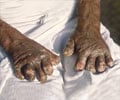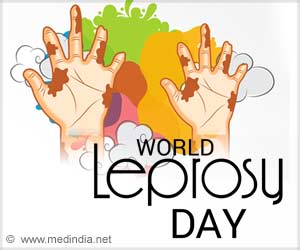- World Leprosy Day is celebrated on 30th January in India and on the last Sunday of January elsewhere
- It generates awareness about the importance of prevention and treatment of leprosy
- It aims to eradicate leprosy from the face of the Earth fully
India has the highest burden of leprosy, accounting for 60 percent of the global burden. However, it is encouraging to know that in recent years, there has been a decline in the number of new cases by over 15,000 between 2016 and 2018. Childhood leprosy cases have also come down below 10,000. Besides India, other high burden countries include Indonesia and Brazil.
Read More..
History of Leprosy
Leprosy is one of the most ancient diseases known to man. It is also called Hansen’s disease after the Norwegian physician-scientist Gerhard Henrik Armauer Hansen, who in 1873 discovered the bacterium Mycobacterium leprae, the causative microorganism of leprosy. This discovery changed the prevailing belief that leprosy was a hereditary disease. The disease is also mentioned in the Bible. According to the Gospel of Matthew, following the Sermon on the Mount, Jesus descended from the hillside and cured a leper by touching and blessing him. Importantly, since pre-biblical times, lepers have been stigmatized and discriminated and considered as social outcasts.Leprosy and its Complications
Leprosy is a chronic infectious disease caused by the slow-growing bacterium M. leprae. Since the bacterium multiplies very slowly, its incubation period is very long. As a result, symptoms may appear even after 5 years post-infection. The disease affects the peripheral nerves, skin, eyes, and the mucosal lining of the upper respiratory tract.The infection spreads from an untreated leprosy patient and is usually transmitted through droplets originating from the nose or mouth. Symptoms include the following:
- Skin patches and lesions
- Loss or reduced sensation in the skin patches
- Tingling/numbness /weakness in the hands and feet
- Swelling on the face and earlobes
Leprosy: Facts & Figures
- Worldwide, 2-3 million people are currently living with leprosy
- Over 200,000 new leprosy cases are diagnosed annually worldwide
- Over 19,000 children are diagnosed with leprosy annually worldwide
- Prevalence rate of leprosy worldwide is 0.2 per 10,000 population
- Average incubation period of M. leprae infection is 5 years
- Symptoms can manifest within one year of infection, but may take as long as 20 years or even longer
- Leprosy primarily affects the peripheral nerves, skin, eyes and the mucosal lining of the upper respiratory tract
- Leprosy is transmitted through droplets from the nose or mouth
- Leprosy can be cured with MDT
- Untreated leprosy can lead to progressive and permanent damage to the skin, eyes, nerves, and limbs
How is World Leprosy Day Celebrated?
World Leprosy Day is fervently celebrated across the globe through various events and activities. On this day, both governmental and non-governmental organizations (NGOs) conduct public outreach programs to inform and educate the general public about the dangers of leprosy, as well as assure them that the disease is now curable. Doctors and other medical professionals advise people on how to recognize the symptoms and prevent the disease from spreading. Leading medical specialists also deliver popular talks to enlighten the public. In addition, rallies, walkathons, marathons and other fundraising events are organized to raise money for the care of those afflicted by the disease.Leprosy: Truths & Myths
Statement | Truth / Myth |
Leprosy is curable | Truth |
Leprosy causes fingers and toes to fall off | Myth |
Leprosy is due to sin, curse or immoral conduct | Myth |
Leprosy spreads very easily and can be contracted through touch | Myth |
Leprosy is hereditary | Myth |
Leprosy is a legal ground for divorce in India | Truth |
157 laws that discriminate against leprosy patients exist worldwide | Truth |
Leprosy doesn’t affect mental health | Myth |
50 percent of leprosy patients suffer from anxiety and depression | Truth |
Eradication of Leprosy
Global and country-level efforts are ongoing to expedite the eradication of leprosy. Efforts by the World Health Organization (WHO) and the Government of India are briefly highlighted below:WHO’s Efforts
- Global Leprosy Strategy: This strategy is WHO’s vision for accelerating towards a leprosy-free world. The timeframe for this strategy is 2016 to 2020. It aims to strengthen government ownership, coordination and partnerships in order to halt leprosy and its complications, as well as stop discrimination and promote inclusion. The three major targets of the Global Leprosy Strategy are as follows:
- No disabilities should occur among new pediatric patients
- Grade-2 disability rate must be less than 1 case per million population
- No country should have laws promoting discrimination against leprosy patients
Indian Government’s Efforts
- National Leprosy Eradication Program (NLEP): The NLEP had its origins from the National Leprosy Control Program (NLCP), which was launched in 1955 by the Government of India. With the advent of MDT in 1982, the NLCP was converted to NLEP the following year, with the objective of eradicating leprosy from India. Early case detection and prompt treatment are the cornerstones for achieving eradication, as these will ensure infection source reduction, as well as halting transmission. By the end of March 2018, the prevalence of leprosy was reduced to less than 1 case per 10,000 population. This elimination goal was achieved in 572 districts (81.13%) out of 705 districts in 29 states/union territories. The ASHAs (Accredited Social Health Activists) played an instrumental role in this effort. Moreover, since 2nd October 2018, post-exposure prophylaxis for close contacts of leprosy patients has been initiated under this program
- Sparsh Leprosy Awareness Campaign (SLAC): This campaign was conducted in 2018 between 30th January and 13th February to raise awareness about leprosy and its complications
- Sparsh Leprosy Elimination Campaign (SLEC): This yearlong campaign was conducted from 2nd October 2018 to 2nd October 2019 on the occasion of the 150th Birth Anniversary of Mahatma Gandhi. The campaign was aimed at reducing the number of new leprosy cases with Grade-2 disability to less than 1 case per million population
- Leprosy Vaccine Development: A vaccine against leprosy has been developed by scientists at the National Institute of Immunology, New Delhi. The vaccine uses the bacterium Mycobacterium indicus pranii (MIP) that can effectively prevent the disease
Key Take-Home Messages
- Leprosy can be cured with timely initiation of MDT
- MDT ensures complete cure, reduces disease transmission, and prevents deformities
- Early case detection and prompt treatment with a full-course of MDT will prevent disability
- Leprosy is not a genetic disease and hence not transmitted from parents to children
- Leprosy can be spread through close and frequent contact with untreated patients
- Leprosy doesn’t spread through casual contact such as shaking hands or sharing office space
- Leprosy doesn’t occur as a divine punishment for past sins, but occurs as a result of infection by the bacterium M. leprae
- Leprosy patients shouldn’t be discriminated in society and should be allowed to live with dignity
References:
- World Leprosy Day 2020: National Health Portal, Ministry of Health & Family Welfare, Government of India - (https://www.nhp.gov.in/world-leprosy-day-2020_pg)
- World Leprosy Day 2019: International Federation of Anti-Leprosy Associations - (https://www.ilepfederation.org/about-leprosy/world-leprosy-day/world-leprosy-day-2019/)
- Leprosy: World Health Organization - (https://www.who.int/en/news-room/fact-sheets/detail/leprosy)
- World Leprosy Day - Bust the Myths, Learn the Facts: Centers for Disease Control and Prevention (CDC) - (https://www.cdc.gov/features/world-leprosy-day/index.html)
Source-Medindia










